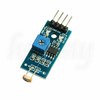Hello all,
New member here, hoping someone might be able to help me with a 'simple' 5V LDR switch circuit.
I want the circuit to be able to toggle a 5VDC relay coil which measures approx 50ohm.
I've set up a 5k pot, LDR, and BC550 as a basic switch and that works well but the issue is that this isn't a dark sensor, it's a slightly-less-bright sensor.
The switching threshold is too bright for my application as I want something to switch after dusk/before dawn.
The LDR that I had was reading around 1.5meg at the kind of darkness I'd like to have as a threshold, but I have ordered some LDRs which max out at around 200k thinking that might help.
That means I don't have an exact value, for now, but the desired LDR threshold resistance will be somewhere close to, but less than, 200k ohm.
Presumably there'll be greater consumption when the relay is held open so, ideally, I'd like the circuit to do that during lower LDR resistance - I.E. during the day. (I'll be solar charging)
I've read a few relevant threads on these forums, looking at darlington suggestions, but I don't fully understand them, if I'm honest.
I'd like to keep it as simple, and as low consumption, as possible.
If it's helpful at all, I do have iCircuit for basic simulations.
Grateful to anyone who may be able to help!
New member here, hoping someone might be able to help me with a 'simple' 5V LDR switch circuit.
I want the circuit to be able to toggle a 5VDC relay coil which measures approx 50ohm.
I've set up a 5k pot, LDR, and BC550 as a basic switch and that works well but the issue is that this isn't a dark sensor, it's a slightly-less-bright sensor.
The switching threshold is too bright for my application as I want something to switch after dusk/before dawn.
The LDR that I had was reading around 1.5meg at the kind of darkness I'd like to have as a threshold, but I have ordered some LDRs which max out at around 200k thinking that might help.
That means I don't have an exact value, for now, but the desired LDR threshold resistance will be somewhere close to, but less than, 200k ohm.
Presumably there'll be greater consumption when the relay is held open so, ideally, I'd like the circuit to do that during lower LDR resistance - I.E. during the day. (I'll be solar charging)
I've read a few relevant threads on these forums, looking at darlington suggestions, but I don't fully understand them, if I'm honest.
I'd like to keep it as simple, and as low consumption, as possible.
If it's helpful at all, I do have iCircuit for basic simulations.
Grateful to anyone who may be able to help!

